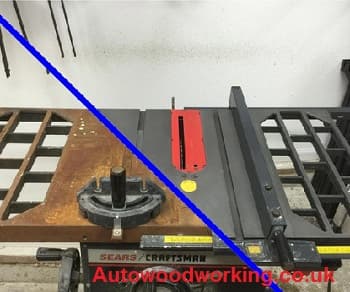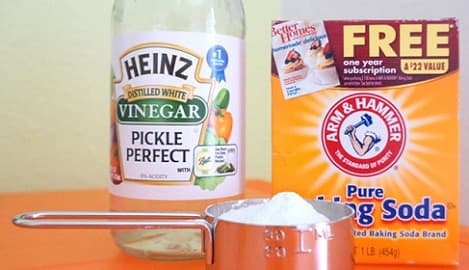As an Amazon Associate, I earn from qualifying purchases.

Rust can be a common issue with cast iron table saws, which can affect their performance and lifespan. If left untreated, rust can continue to spread and cause irreversible damage. Therefore, it is crucial to remove rust from your cast iron table saw and prevent its recurrence. In this article, we will discuss effective methods to remove rust from a cast iron table saw, along with some preventive measures.
Understanding Rust on Cast Iron Table Saw:
Cast iron is prone to rust due to its iron content and exposure to moisture or humidity. Rust is formed when iron reacts with oxygen and moisture, resulting in the oxidation process. If not addressed promptly, rust can corrode the surface of the cast iron, leading to pitting and roughness, which affects the smooth operation of the table saw.
Importance of Removing Rust:
Removing rust from your cast iron table saw is essential for several reasons. Firstly, rust can compromise the accuracy and precision of your cuts, affecting the quality of your woodworking projects. Secondly, rust particles can mix with sawdust, causing abrasive damage to the table saw’s moving parts. Lastly, by maintaining a rust-free table saw, you ensure its longevity and protect your investment.
Tools and Materials Required:
Before starting the rust removal process, gather the following tools and materials:
- Soft-bristle brush or nylon scrub pad
- Vinegar
- Baking soda
- Clean cloth or sponge
- Naval jelly
- Electrolysis tank (for electrolysis method)
- Wire or brush for cleaning (for electrolysis method)
- Rust-resistant coating (optional)
- Gloves
- Safety goggles
- Respirator mask
Preparing the Work Area:
To ensure an efficient and safe rust removal process, prepare your work area adequately. Clear the surroundings of any unnecessary items or debris. Place a protective covering, such as a tarp or old newspapers, to catch any drips or spills. Adequate ventilation is crucial, so if working indoors, open windows or use fans to circulate the air.
Safety Precautions:
When dealing with rust removal, it is essential to prioritize safety. Wear gloves, safety goggles, and a respirator mask to protect yourself from chemicals and rust particles. Work in a well-ventilated area to minimize exposure to fumes. Additionally, follow the instructions provided by the manufacturers of the rust removal products and tools.
Contents
Method 1: Using Vinegar And Baking Soda

Step 1: Cleaning the Surface
Begin by cleaning the cast iron table saw surface using a soft-bristle brush or nylon scrub pad. Remove any loose dirt, dust, or debris that may be present.
Step 2: Preparing the Solution
In a container, mix equal parts of vinegar and baking soda to create a paste. The vinegar’s acidity and the baking soda’s abrasiveness work together to dissolve and remove rust effectively.
Step 3: Applying the Solution
Using a clean cloth or sponge, apply the vinegar and baking soda paste onto the rusted areas of the cast iron table saw. Ensure that the paste covers the rust completely.
Step 4: Scrubbing and Removing Rust
Gently scrub the rusted areas with the paste using circular motions. The combination of vinegar and baking soda will react with the rust, loosening its grip on the surface. Continue scrubbing until the rust is visibly reduced or removed.
Step 5: Rinse and Dry
Once the rust is removed, rinse the cast iron table saw with water to remove any residue from the vinegar and baking soda mixture. Dry the surface thoroughly using a clean cloth or allow it to air dry completely.
Step 1: Surface Preparation
Ensure the cast iron table saw surface is clean and free from loose debris. Wearing gloves, apply a thin layer of naval jelly to the rusted areas using a brush or sponge. Naval jelly contains phosphoric acid, which converts iron oxide (rust) into a more stable compound.
Step 2: Applying Naval Jelly
Allow the naval jelly to sit on the rusted surface for the recommended amount of time specified by the manufacturer. This time may vary depending on the severity of the rust.
Step 3: Scrubbing and Removing Rust
Using a soft-bristle brush or nylon scrub pad, scrub the rusted areas gently. The naval jelly will react with the rust, making it easier to remove. Continue scrubbing until the rust is dissolved or loosened.
Step 4: Rinse and Dry
Thoroughly rinse the cast iron table saw with water to remove any traces of the naval jelly. Dry the surface completely using a clean cloth.
Method 3: Electrolysis
Step 1: Setting up the Electrolysis Tank
For severe rust or larger cast iron surfaces, electrolysis can be an effective method. Create an electrolysis tank by filling a plastic container with water and adding a water-soluble electrolyte, such as washing soda or baking soda, according to the manufacturer’s instructions.
Step 2: Submerging the Cast Iron
Submerge the rusted cast iron table saw in the electrolysis tank, ensuring that the rusted areas are fully covered by the water. Attach a sacrificial anode, such as a piece of steel or iron, to the positive terminal of a battery charger.
Step 3: Running the Electrolysis Process
Connect the negative terminal of the battery charger to the cast iron table saw. Turn on the charger, and the electrolysis process will begin. The electrical current will cause the rust to convert back to iron, effectively removing it from the surface.
Step 4: Cleaning and Drying
Once the electrolysis process is complete, carefully remove the cast iron table saw from the electrolysis tank. Use a wire brush or scrub pad to clean off any remaining rust or debris. Rinse the surface with water to remove any residue from the electrolyte solution. Thoroughly dry the cast iron surface with a clean cloth.
Preventing Rust On Cast Iron Table Saw

Prevention is key to maintaining a rust-free cast iron table saw. Follow these steps to minimize the chances of rust formation:
Step 1: Regular Cleaning and Inspection
Regularly clean the cast iron surface of your table saw to remove any dust, debris, or moisture that may accumulate. Inspect the surface for any signs of rust and address them promptly to prevent further damage.
Step 2: Applying Protective Coating
Apply a rust-resistant coating, such as paste wax or oil, to the cast iron surface. This protective layer acts as a barrier, preventing moisture and oxygen from reaching the metal and causing rust. Follow the manufacturer’s instructions for the specific coating product you choose.
Step 3: Proper Storage
When not in use, store your cast iron table saw in a clean, dry environment. Avoid storing it in areas prone to moisture, such as basements or damp garages. Consider using a cover to further protect the surface from dust and moisture.
FAQs (Frequently Asked Questions)
Can I use sandpaper to remove rust from my cast iron table saw?
Sandpaper can be used for light rust removal, but it may scratch the surface. It’s best to start with milder methods and reserve sandpaper for stubborn rust patches.
Is it necessary to remove all the rust from my cast iron table saw?
While it’s ideal to remove as much rust as possible, focus on removing the majority of it and creating a smooth surface. Some minor traces of rust may not affect the performance significantly.
Can I use rust converters instead of naval jelly?
Rust converters can be an alternative to naval jelly. They chemically convert rust into a stable compound, eliminating the need for scrubbing. Follow the instructions provided by the rust converter manufacturer.
How often should I apply a protective coating to my cast iron table saw?
It is recommended to apply a protective coating every few months or as needed. Monitor the surface regularly and reapply the coating when you notice signs of wear or reduced effectiveness.
Can I prevent rust by keeping my cast iron table saw indoors?
While storing your table saw indoors can reduce the exposure to moisture, it is still essential to follow proper cleaning and maintenance practices to prevent rust formation.
Conclusion
Maintaining a rust-free cast iron table saw is essential for optimal performance and longevity. By following the methods outlined in this article and implementing preventive measures, you can effectively remove rust from your table saw and prevent its recurrence. Regular cleaning, appropriate coatings, and proper storage will ensure that your cast iron table saw remains in excellent condition, providing accurate and precise cuts for years to come.



